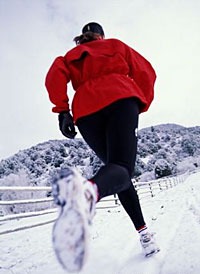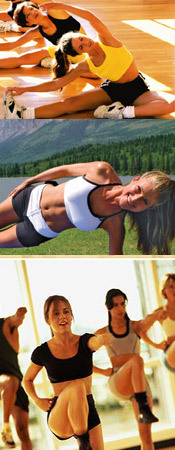 |
 |
|

One of the best ways to stick to your workout plan is to have a workout
buddy - somebody who will be counting on you to show up. You might
decide to carpool with a friend to a yoga or aerobics class, or
maybe you make a new friend at the gym, or find a fellow runner in your
neighborhood who you can keep pace with. When your own personal
motivation to get fit (or keep your resolution) isn't enough to get you
out the door, knowing that you've made a commitment to your workout
buddy probably will. You can encourage each other when you're not
feeling it, and celebrate your triumphs and successes together.
Set
goals that you know you can obtain. You won't be able to lose 30
pounds in one month, and you probably won't be able to hit the gym
everyday. Instead, set a goal for something you know you can achieve, such
as signing up for and taking a new class at your gym, working up to a
higher number of reps or higher weights in your workout. You could also find new
ways to incorporate exercise into your daily life- such as taking the
stairs at work, or doing ab exercises while waiting in the line at the
grocery store or while sitting in your chair at work. Tell people about your
goals. Not only will this create an expectation for you to achieve
them, but it will help keep those goals on your mind. Don't be afraid to
ask for support from your family and friends.
|
|
 |
 |
 Planning
ahead
is essential when eating for strength training. There are
many nutritional components that help optimize your body to increase
strength. The
following sample menu from
www.building-muscle101.com, is specifically designed to enhance your strength training. Planning
ahead
is essential when eating for strength training. There are
many nutritional components that help optimize your body to increase
strength. The
following sample menu from
www.building-muscle101.com, is specifically designed to enhance your strength training.
Sample 2,500 calorie per day
Breakfast:
- ½ cup bran flakes
- 1 cup 1% milk
- 1 medium peach
- 1 whole wheat toast
- 1 tbsp peanut butter
Mid-Morning Meal:
- ½ cup strawberries
- ½ cup low fat yogurt
- 1 scoop (2oz) vanilla protein powder
- 1 cup 1% milk
- ½ cup orange juice
Lunch: Peach Chicken and Rice
- 2 oz skinless chicken breast
- ½ can sliced peaches
- ½ tsp of cornstarch
- ½ tsp peeled and grated ginger
- 1/4 tsp salt
- 1/4 cup water chestnuts
- ½ cup rice (uncooked)
- ½ cup snow peas
- ½ tsp extra virgin olive oil
Mid-Afternoon Meal:
- 3/4 cup 1% cottage cheese
- ½ can (4oz) can peaches- sliced
- 1 English muffin
- 1 tbsp peanut butter
Post-Workout Meal: Power Drink
- 1 scoop protein powder (2oz)
- 1 cup orange juice
- 1 medium banana
- 1 cup 1% milk
- ½ tbsp honey
Dinner: Chicken Teriyaki
- 4 oz skinless chicken breasts
- 1/3 cup low sodium teriyaki sauce
- 1/3 cup orange juice
- 1 tsp cornstarch
- 1/3 tsp ginger
- ½ tbsp extra virgin olive oil
- 1 ½ cup small broccoli florets
- 1 can (8 ounces) sliced water chestnuts
- 1/4 cup rice (cooked)
|
|
 |
 |
 It
is easy to feel morose when the weather is gray. It gets dark before
you get home and you're faced with rainy days more often than sunny.
Many people suffer from seasonal depression, or in more intense cases,
SAD: Seasonal Affective Disorder. If you find that you are battling
the winter blues, you might try increasing the frequency of your
workouts, adding some new exercises to your regimen, or stepping up
your existing training. It
is easy to feel morose when the weather is gray. It gets dark before
you get home and you're faced with rainy days more often than sunny.
Many people suffer from seasonal depression, or in more intense cases,
SAD: Seasonal Affective Disorder. If you find that you are battling
the winter blues, you might try increasing the frequency of your
workouts, adding some new exercises to your regimen, or stepping up
your existing training.
Exercise
has several benefits,
both physical and mental. In the case of the winter blues,
exercise can provide the brain with feel-good hormones needed to get
you going again. Some studies have shown that you can remain in
an
altered state for up to four hours from exercise. Even ten
minutes of light exercise, such as walking, can have this kind of
effect. Many studies have also shown that even fifteen minutes of
activity can increase brain function and enhance learning
abilities.
If you're having trouble staying awake or paying attention, you might
choose to go for a walk at lunch rather than take a nap- you'll feel
more energized and be better prepared to focus on the rest of your day.
A
study by the Duke University Medical System followed 156 patients during a
course of treatment for depression. The patients were split into three
groups; one group was assigned exercise (30 minutes/ 3x week), one
group assigned medication, and one group was assigned both exercise and
medication. At the end of the study, the patients were re-evaluated using
standard measurements of depression. All three groups showed
substantial improvement, and even more importantly- identical rates of
improvement. This would indicate that exercise is just as effective a
treatment for depression as medication.
|
|
 |
 |
|

Water exercise is a low impact way to work your muscles and can be done
in any pool or spa. Water exercise is good for any person, regardless
of age, gender, or fitness level. By finding a spa or pool to do your
exercise, you are well on the way to becoming a water exercising pro!
While doing these water exercises you will help relieve your
joint pain and back pain. Also, water exercise is good for women who
are pregnant and people who may be overweight.
Doing water exercises in a spa with warm water helps to relax your
muscles - allowing you to perform better while allowing you to feel
comfortable. Pools allow more space to do more exercises, but many pools
are not heated so your muscles are not able to relax as mush as with a
spa (the choice of where you go is yours, and only you can make it).
There are many light-weight pieces of equipment you can use while
exercising. One is a buoyancy belt that will help suspend you in deeper
water. Kick boards help build leg muscles, while using light-weight
dumb bells or wrist weights add to the resistance and help tone and
strengthen the upper body. Be sure to wear the proper type of water
shoes and clothing while doing these exercises. Thick clothing will
weigh you down more, while improper water shoes cause more strain on
your feet and cause less buoyancy.
Water exercises can be done alone or with a friend - the more the
merrier. Also, by putting on your favorite type of music, you can put
your exercises to a beat, making it a little more fun for you and your
friends. If possible, you and your friends should try to do these water
exercises 3-4 times weekly.
Water exercise will give you many benefits, one of which is muscle tone
and body strength. Another is weight loss. While exercising alone will
help you lose weight, water exercise allows your muscles to relax and
not have as much strain put on them. Lastly, water exercise will help
lower you blood pressure and help lower blood sugar levels, and
lower stress - in turn helping your heart more than you could
imagine.
If you have any health problems, such as those stated above, find a pool
or spa, jump in, and get to work. Do the water exercise that is right
for you, and start feeling great about your exercise routine.
|
|
|
 |
|
In This Issue:
|
|
 |
|
Training Updates
|
#my_firstname# #my_lastname#
#my_phone#
|

|
|
Winter Weather Brings Winter Squash
|
|

Eating seasonally is
plenty easy in summer when fresh produce is available in abundance.
Come winter time, the options may be slimmer, but are no less
delicious. Here are a few ideas on how to prepare winter squashes such
as butternut, acorn, kabocha, or buttercup squash:
- Make
soup! All of these squashes make wonderful soups and bisques. You can
pair them with yellow split peas and curry or sweet potatoes and ginger
with a hint of cayenne, it's up to you. Don't be afraid to experiment
with soup.
- Roast squash: covered in foil with a little bit of olive oil and rosemary, these sweet squash make a fragrant side dish.
- Baked
squash: cut in half or cut into slices and bake this squash with a
little water in the pan. You can add sweetness in the form of butter,
brown sugar or maple syrup, or add spices such as cinnamon or ginger
for a spicier sweetness.
- Do a rootbake using other seasonal veggies (beets, potatoes, turnips, carrots) and season to your taste.
- Add these squash to a casserole where you usually use sweet potatoes.
|

|
|
Tips for Running Outdoors in Winter
|
If running is a
regular part of your workout, or something you simply enjoy doing, don't
let cold winter days stop you from getting out there and hitting the
pavement or trail. The following are a few tips for making sure that
you stay safe and healthy on these cold winter days:

- Dress in layers. As you run, you're going to warm up, and you want to be able to remove layers or add them back on, as needed.
- Wear fabrics that will wick moisture away from your body. This reduces chill will prevent athlete's foot.
- Wear a hat and gloves. The majority of heat loss occurs from your head and extremities.
- Don't forget that sunblock. Just because it is cold doesn't mean you shouldn't protect your skin from harmful UV rays.
- Warm up gently and slowly. Pay close attention to how your body feels.
- Don't run on ice, and wear sunglasses if running in snow to prevent snow-blindness.
|

|
|
In a hurry?
|
With this two minute ab workout, you don't have any excuse for not doing your exercises.


|
|
 |